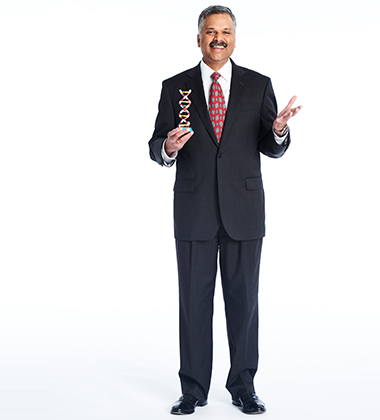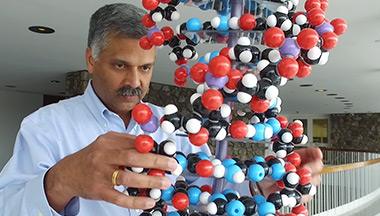Ajay Royyuru
- Director, Healthcare & Life Sciences Research
- IBM Research
- BS Human Biology & MS Biophysics, All India Institute of Medical Sciences
- PhD Molecular Biology, Tata Institute of Fundamental Research
Ajay has been at the forefront of IBM’s genomic work, including leading the Genographic Project partnership with National Geographic, which collected and analyzed hundreds of thousands of DNA samples to study human migration patterns.
In his own words

… on a mentor’s inspiration
My undergraduate advisor at AIIMS, Dr. Vidya Kothekar, was a major influence on my decision to pursue the intersection of biology and computational modeling. During my second year, I took her biophysics class. At the time I had no experience with computers and programming but she threw me in. She was using computers to calculate the physics of atomic interactions of molecules: DNA, short proteins and drugs. While I could relate to the molecules — it was a thrill to learn and work on DNA structure — the computational methods were an extremely steep learning curve. She would give me a task in the morning, such as “try displacing the drug molecule a few Ångströms further into the groove of DNA,” and expect that I not only figure out how to do this in the computational model, but also learn the physics of this interaction. Often, I was still struggling at this task by nightfall, and she would come back after dinner to finish what I had started. Her high work ethics were an inspiration.
She turned on the computing gene in my head and got me working on a computational research problems before I had my degree — even encouraging me to do research that could be published! My first publication in 1986 was one of seven I wrote with Dr. Kothekar. As a kid getting acquainted with the practice of science, just seeing the fruit of that as a peer-reviewed publication was a thrill.
… on joining IBM
While I was a postdoc in the 1990s, a colleague put a yellow sticky on my computer screen that simply said “Computational biology manager” with an IBMer’s email address. I wrote to him thinking this was for a job opening: “I hear there is a position for a manager of computational biology and I’d like to be considered.” The reply I got back showed how short-sighted I had been, and good-humored the hiring manager was. He said that as far as he knew he already had that job, but was looking for [another role] if I was interested!
I interviewed, and got an offer, but I turned it down as I didn’t appreciate or understand what I could do at IBM. Two years later, though, that same manager asked if I was still interested. And a lot had changed since — like the Human Genome Project. Biology had become an information science, and the challenge would be in what to do with all of this data. So I decided I could be a more effective biologist at IBM.
IBM interview two was in 1997. This time I was going to ask about what they wanted me to do. The answers I got hooked me. First, a senior manager said that if they had to tell me what to do, then I was the wrong person for the job. Then, the head of Research at the time, Paul Horn, told me that true exploratory research has to be undirected research; “so if you know what you want to do, you’d better be the best at it.” It was so open-ended that I was pinching myself!
… on the intersection of biology and computation, and its future
Not long after I joined, Paul Horn asked me how a protein knows how to fold. It was a biology problem wrapped in physics modeling that only a supercomputer could answer. The years of science we did from that one thought led to Blue Gene, and the top spot in 2004’s TOP500 list. Blue Gene systems have helped model a wide range of biological phenomena, from molecules to organs, as well as tackle a wide range of complex simulation problems in astronomy, climate and medical therapies.
Then, National Geographic’s 2005 Genographic Project, to map human migration patterns via DNA analysis, was another project I worked on that seemed out of IBM’s comfort zone. But we saw an opportunity to develop completely new analysis of this unique data — and to be relevant in genomics. The project has since been applied to plant genomes to help save cacao, as well as keep us safe from food-borne illnesses.
Now, I’m working with IBM Watson Health on cancer research, using Watson for Genomics. We’re building a system of insight to translate genomic variations in cancer treatment decisions. Today 15 leading medical institutions use it as a research tool to inform deliberations on new cancer patients. Clinicians can look at the patient’s raw genetic evidence to determine personalized treatment options.
… on what he’s reading right now
Right now I am reading The Vital Question by biochemist Nick Lane. And I also very much enjoyed Anil Ananthaswamy’s The Man Who Wasn’t There.
